In “Fantasy and Synesthesia, the creator transfers to the canvas the mental faculty that allows him to turn letters and sounds into colour abstractions.
Jose Dulce, S/C of Tfe.
Until now we knew that music had a colour and kept relation to mathematics. What it’s not so extended its
the faculty of mind to translate sounds into chromatic abstractions.
This transference of impressions from a sensorial field to another one finds a suggestive way in the show of David Moratón “Fantasy and Synesthesia”, closing today in the Art Hall Los Lavaderos at the capital of Tenerife
– How is, in your case, the painting or sensations?
– The “sensational thing” is not in fact something recent, already from Prehistory times there have been periods of deep sensoriality. Yes it’s true that in the west world, in last two thousand years, senses have suffered all kind of humiliations and confinements, mainly by the so called “parents of the Church” and this had its reflection in art. From the Romanticism, nevertheless, the light of the sensorial world – not the artificial light of reason- began to illuminate corners of the mind that until then had remained in darkness. At the beginning of the XX Century the interest to combine the senses and the arts consolidated, an interest woken up at the end of the previous century, specially with the Wagner’s “Gesamtkunstwerk” concept (total work of art). In my case, this synesthesia not only arises from the love to sensations, but mainly from a perceptual anomaly that luckily or unfortunately have. Neurology defines it as an infrequent upheaval of perception in which the stimulus through one of the senses causes sensation in another simultaneously. When I listen to a sound, I see abstract forms of colour at the same time, and is something that I cannot avoid. Also it happens lo some scents and when thinking about vowels or letters, that I see suddenly coloured in my mind
– In works like “Titan” or “The Decision”, reason and symbol are contained mutually. How do you let the viewer know the meaning of the work without reducing its mystery?
– Those works belong to the series Fantasy, that I made during my stay in Hannover. At that time was not still fully trying to represent my synesthesic impressions. For me, the form is to the service of a philosophical content and a fantastic experience: and attempts to represent the same mystery, which Einstein called “the fundamental emotion, bases of the true art and true science”. The characters of those pictures decide to advance towards the unknown and that turns them into titans, because only grows the one going through unknown paths.
– Why the painting made in the Islands has so little fantastic flight?
– There are exceptions, but the art of the Islands, in general, tends to be a reflection of the one of the great capitals, and in the contemporary pictorial panorama it is infrequent to find a narrative or fantastic speech. Everything is almost form, abound the speeches on rhetoric and the concept in art, the object, the context of the representation. That does not interest me. I have always painted what it has made me vibrate, a fantasy, a dream, a philosophical concept, a musical or literary work, or a sound, independently of formal fashions or speeches. It is necessary to live the painting. Art must be a power plant, and the moments of artistic creation should not be different from the moments of game in childhood
– Which is the process of getting the sound until it is shaped with colours on the canvas?
– Synesthesia is little known. Science has been only taking care seriously of this phenomenon for about forty years. At the moment prestigious American neuologists like Cytowic, Ramachandran, Baron-Cohen or Grossenbacher agree in affirming that the synesthesics are mentally healthy people, and who in addition constitute a precious opportunity to study the brain and to understand the secrets of the conscience. How takes place the synesthesic impression – demonstrated with tests of magnetic resolution- it is still a mystery; and represent what | see is not simple. What appears in my conscience is abstract and fleeting. In addition, a sound or music is defined by time. Nevertheless, the painting is space. How to relate them?, That is the main challenge. It must be created a convention, a language of the space-time. I must make an effort to clarify the chaos of colours that arise in my mind with a musical work, “seeing every moment, each variation, distinguishing the colours of the instruments and positioning the colours in the space in a legible and harmonic way,
– To what extent the language of composers like Sibelius or Rautavaara evokes images?
– I have studied and listened to much music, it’s a passion for me as much as painting. I could paint any musical work, but always choose those that communicate something more than pure sound, those that drive me to a catharsis. Messiaen wrote down in its scores the colours that he wanted to evoke. Einojuhani Rautavaara, the most important Finnish composer after Sibelius, is one of the few that still feel comfortable defending the content and the “program” in the art. Three of my works are based on his compositions like “Angels and Visitations” inspired as well by a dream and a poem of Rilke. Some other works arise, like mine, from Edgar Allan Poe stories. Like Messiaen, Rautavaara has the ornithological into his themes, recurrent in his work, even introducing sometimes real sounds of birds in the composition. In my case, seven of works exposed in Fantasy and Synesthesia are painted sounds of birds. In general terms, I try to fusion with the sound, the fantasy, the content of the pictorial work. It’s a way of meditation, to feel that l am part of something immense: to reach in the creation – as also affirms Rautavaara- an oceanic feeling.
The Phrases
How the synesthesic impression is produced is still a mystery
The moment of creation shouldn’t be different than the moment of playing in childhood
Foto: David Moraton in front of one of his works exhibited in “Fantasy and Synesthesia”, solo show that ends today.
El Dia, Tenerife, Spain
30 September
2004

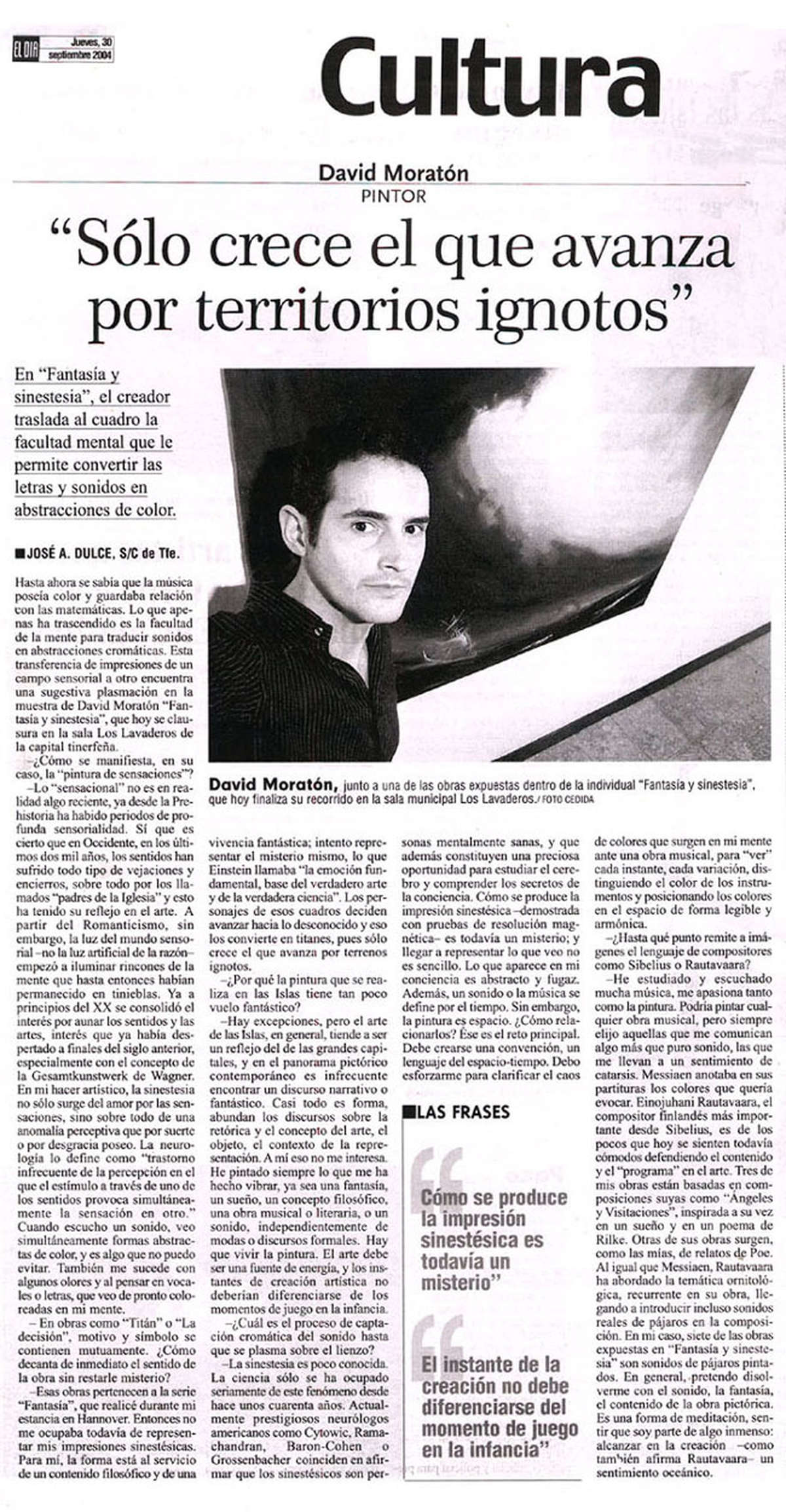
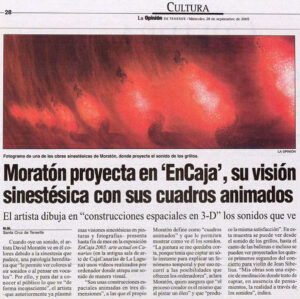
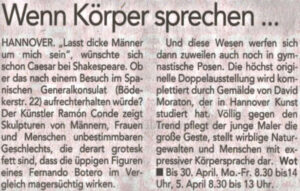
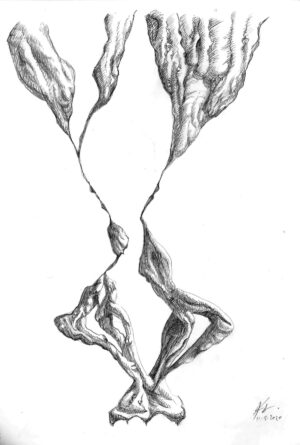
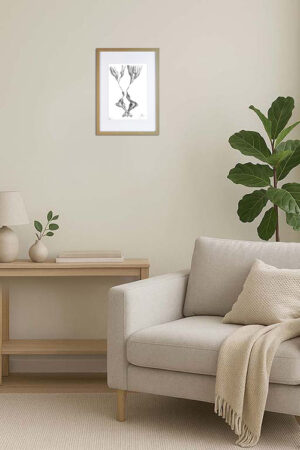
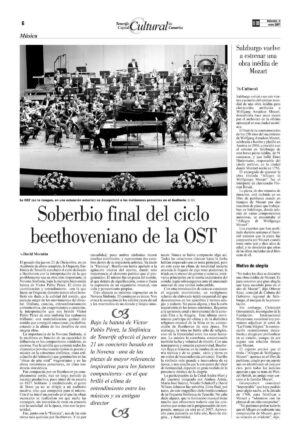
Reviews
There are no reviews yet.